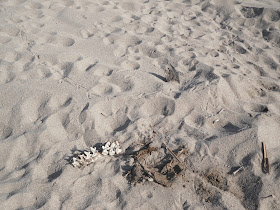Well all-righty then, if you are an American reader you probably spent yesterday stuffing your face scavenging a turkey carcass. And so in the spirit of all things dead and what happens to those dead things let's revisit my visit to the Santa Clara River estuary.
First of all I want to revisit the setting, specifically to show how narrow the beach berm- which separates the ocean from the estuary- is.
What should be immediately apparent, and which has direct taphonomic implications, is the intense intermingling of a variety of habitats. You have the river/estuarine system, which can contain not only organisms who live in these systems- but also any organisms from the surrounding habitats of the watershed that get flushed down the river. In fact during heavy flood events piles of debris get pushed down the river and deposited on the beach. One of the most common animals found in these debris flows that survives- rattlesnakes. And of course right next door to the river estuary is a high surf/intertidal zone. This beach in particular is noted for heavy surf and rip tides. What may or not be apparent is that this storm surge routinely breaks the berm and floods into the estuary. Along with saltwater intrusion that is left behind, any other debris (i.e. bodies) that the ocean coughs up are left behind- often times on the estuarine side of the berm. What should become immediately apparent from a taphonomic view point, is that organisms from both deep sea pelagic environments and inland chaparral communities can be deposited right next to each other here. And since this is a depositional site there is some potential for preservation- however slight it is. And so imagine the difficulties the intrepid paleontologist of the future might have in such an area trying to tie an animal to a habitat. What if you found rattlesnake, grebe, and dolphin all adjacent to one another?
Above is the partial remains of most likely a common dolphin, Delphinis delphis. Not being a marine mammal expert (or expert in anything really haha) I am just making an educated guess for a common mid sized dolphin in the area. If I am wrong correct me in the comments please.
What was sort of grimly interesting was that there was evidence of at least two dolphins, the tail of a very small dolphin ( the baby of the larger?) was found close by. Fingers for scale.
But I can be wrong. Notice how quickly I went to a social link between the two sets of remains. Maybe they were just deposited near one another due to taphonomic processes? In fact there is much to suggest that this is more often the cause. At a different part of the berm I found where two sea lion bodies (Zalophus californianus) had been deposited adjacent to one another.
Now in this case both remains were well grown, although highly modified/weathered individuals. Nothing to suggest a social link between the two individuals. But they were the only sea lion remains I found in my cursory walk and were left only 10 meters apart. Interesting to ponder why they would end up in the same area. An interesting confluence of algal poisoning, tides, storm surge and beach morphology to funnel the bodies into the same area? What is also interesting was how quickly my mind went to social bond when I saw the infant dolphin tail next to a larger dolphin and I did not think the same for the two sea lions...
Well I hope these two posts were interesting or useful to you. Here are some pics of birds (living) at the estuary/shoreline.
Support me on Patreon.
Like antediluvian salad on facebook.
Watch me on Deviantart @NashD1.Subscribe to my youtube channel Duane Nash.
My other blog southlandbeaver.blogspot.

















I´m thinking in a zoo (as a sad example a zoo destroyed by a bomb), guess what a future paleontologist can imagine looking at the remains. You are right, backyard nature has much to show.
ReplyDelete